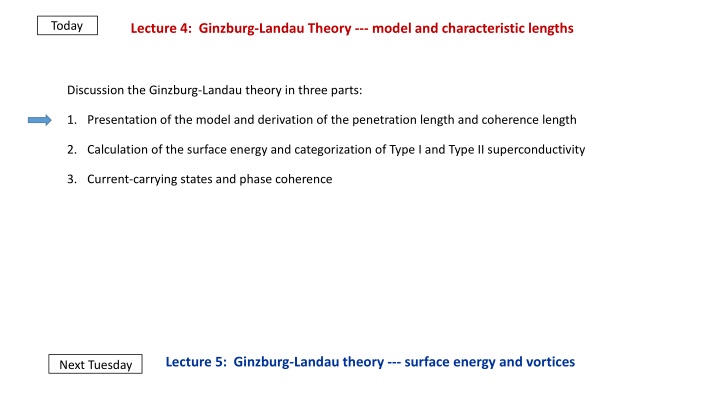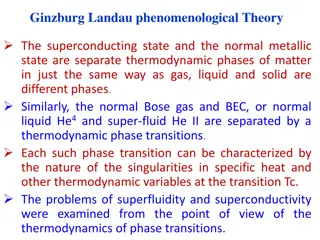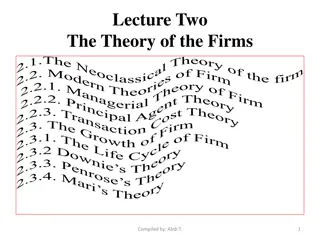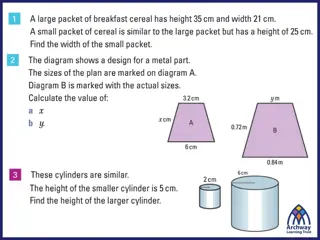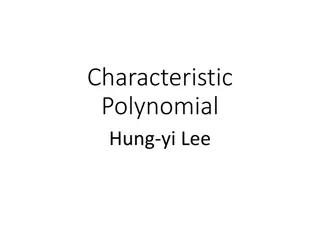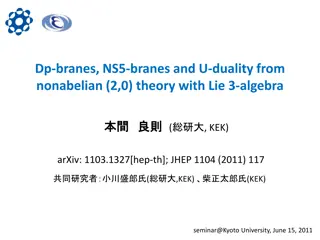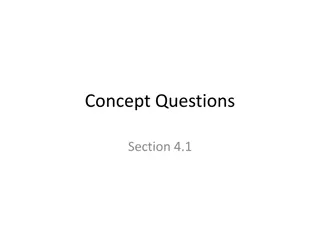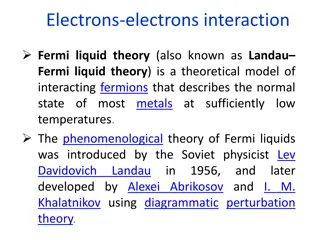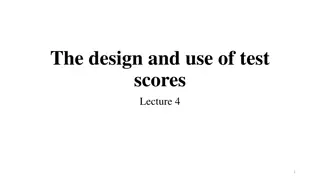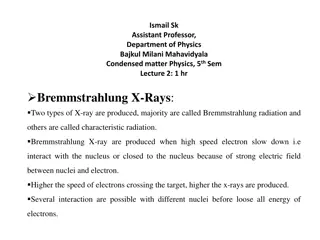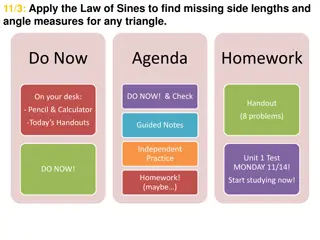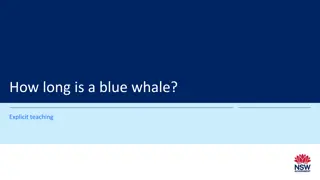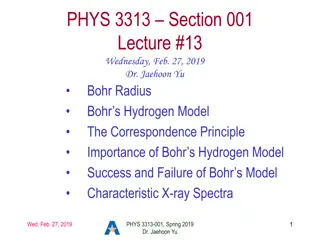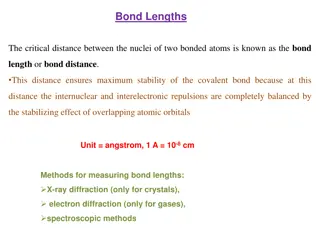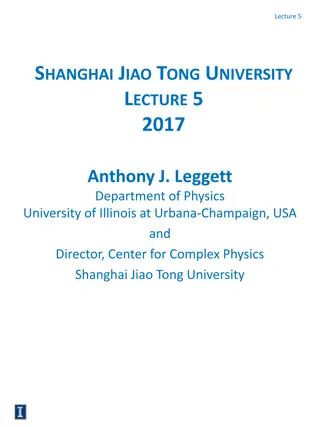Ginzburg-Landau Theory: Model and Characteristic Lengths Discussion
Ginzburg-Landau theory is discussed in three parts, focusing on the model derivation of characteristic lengths such as penetration length and coherence length, calculation of surface energy for Type I and Type II superconductivity, and exploration of current-carrying states and phase coherence. The lecture series delves into the non-local modifications by Pippard and London, addressing the relationship between impurity concentration and penetration depth. Insightful visuals and theoretical explanations contribute to a comprehensive understanding of the topic.
Download Presentation

Please find below an Image/Link to download the presentation.
The content on the website is provided AS IS for your information and personal use only. It may not be sold, licensed, or shared on other websites without obtaining consent from the author.If you encounter any issues during the download, it is possible that the publisher has removed the file from their server.
You are allowed to download the files provided on this website for personal or commercial use, subject to the condition that they are used lawfully. All files are the property of their respective owners.
The content on the website is provided AS IS for your information and personal use only. It may not be sold, licensed, or shared on other websites without obtaining consent from the author.
E N D
Presentation Transcript
Today Lecture 4: Ginzburg-Landau Theory --- model and characteristic lengths Discussion the Ginzburg-Landau theory in three parts: 1. Presentation of the model and derivation of the penetration length and coherence length 2. Calculation of the surface energy and categorization of Type I and Type II superconductivity 3. Current-carrying states and phase coherence Lecture 5: Ginzburg-Landau theory --- surface energy and vortices Next Tuesday
Pippard Non-local Modification to ? ? Brian Pippard (Cambridge, 1953) ? ? ? depends on a weighted-average of ? over a range ? = coherence length ? 1 ? ? ? ?? ? = LONDON ? = ? ? ? ? ? ? ? ?4 1 ? 3 ?? ?3? ? ?? ? = PIPPARD 4??0 ? ? How did he get this form? CHAMBERS expression for non-local resistivity (replacing ?? ? = ?? ? ) 4? ? ? ? ? 3 ? ?3? ?? ? = ? ?4 Here, range of influence is due to memory over time between scattering events
Range of non-locality for SC: Values of ?0 ? = Pippard coherence length ?? ?? ?? ?? ???? ??3?? ???? ?,? ???? ? 1600 ?? 230 ?? 83 ?? 38 ?? 20 ?? 4 ?? 1.5 ?? 0.4 ?? DIRTY SC ?0 CLEAN SC ( ?0) ?0 ?0+ ? = ?0 ? = ~ 1 ?=1 +1 ?0 ? ~ ?0 CLEAN DIRTY
Non-locality: ? vs. ? NON-LOCAL (Pippard) LOCAL (London) ? >> ? ? ? ? ? Averages in current from higher ? effective increase in ? by ~ ? ? ? ? ? ? ? ? ? = 1 ? ~ 1 ? ? ? ? ? ? 4?? ? = 1 ? ? ? 4?? ? = 1 ? ? = ? = ? ? ? ? 1 ?2= 1 ? ? ?2? = 4? ? ? 1 ? ? 1 ?2? ?2? = 4? 1 ? = ? = ?2 ? = ?L2? ?L2 ?2 ?L2 13 13> ?P>?L ? ?L 13= ?L ? ?L ? = ?L2? ? = ?L ?= ?L 13 ?0 ?L 13= ?L ?? = ?L2?0 Pippard penetration length:
Non-locality over the coherence length modifies the penetration depth depending on the impurity concentration: In CLEAN LIMIT ? = ?0 ??> ?0 ? = ?? LONDON 13 ?0 ?? 13 PIPPARD SC ??< ?0 ? = ??= ?? > ?? PIPPARD ?0 ?? ?0> ?? ??= ?? ? LONDON SC ?0< ?? ?? ?0 ~ In moderately DIRTY limit 13 CLEAN ?? DIRTY ?0 ? = ?? ?? ?~ < ??,?0 In very DIRTY limit Pippard coherence length and non-locality was introduced to explain the impurity-dependence of the penetration depth Always in London (local) limit ? ? ? Pippard expression: 12 ?~ 1 ?0 ?0 We will see a similar but different coherence length emerge from the Ginzburg-Landau theory ? ? = ?? > ??> ?? ?
GINZBURG LANDAU THEORY (1950) Phenomenological allows for spatial variations of properties not included in London equations (local electrodynamics) Order parameter ? ?complex wavefunction ? ? ??? ? 2 = ?? two-fluid model Superconducting electron density ? ? Vitaly Ginzburg Lev Landau Not widely outside Russia in the early days --- thought to be too phenomenological --- until --- 1959 Gorkov (using thermal Green s functions) showed that GL BCS in limit of near ??, slowly varying fields and currents and ? ? ? ? ~ ? energy gap parameter (related to , gap in excitation spectrum) Lev Gorkov BCS gap parameter which depends on qp s Now widely accepted and applicable to many problems We will follow the presentation (by Ginzburg and Landau) --- not the microscopic derivation (by Gorkov)
GINZBURG LANDAU MODEL and free energy near phase transition in ?2 in zero field Simplest possible form: cannot expand in ? since G must be real odd terms not allowed since G is analytic at ? = 0 ? 0 = ??0 ??0 = ? ?2+1 2? ?4 ? ? ? > ? or else minimum ? at ? NORMAL STATE SUPERCONDUCTING STATE ? ? ? ?2 = 0 as before (G-C model) ? < 0 ? ? ? > 0 ? ? = ?2 ?2 ?= 1 ?2 ?= ??2 ?+1 2 2 8? ? ? Condensation energy ? ? 0 4??2 ? Mexican hat potential ? < 0 ??< ?? ??= Minimum ? at ?2= ? ?> 0 Minimum ? at ? = 0
What about ? ? What about ? ? ? = ?? ??> 0 ? > 0 ? = 0 ? = 0 ? > ?? NORMAL GL assumed ? ? = ? ??= constant ??2= 4??2 ?~ ?? ?2 ?? ? ~ ?? ? which is observed near ?? ? = ?? ? < ?? TRANSITION SC ? < 0 ? < 0 Finite fields allows currents, spatial variations: 1 ??(?) = ??0 +?2 With geometry effects (intermediate state): ? = 0 8? ? ?2 8? ??(?) = ??0 + ???? ? If field ? penetrates, energy required to expel field is smaller ?? ??0 ?? ? ? ? ? ?? ??0 ? ?? "??2 1 ? ?? "??1 ?
2 ?? 1 ? ? 2 ???= = kinetic energy 2? ? 2 2+ ?? ? 1 ? = ? ??? for 2? 2? ? ?2 = ? gradients in ? (interface N-S) kinetic energy of pairs (supercurrent) ? ? ? ?? 1 2? ??2 = ? ?? GL only strictly valid at ~?? but extensions to lower ? are useful and often give useful results All quantities obtained from 2 experiments ? vs. ? and ?? vs. ? all thermodynamics, electrodynamics, complex cases where fields and currents vary (e.g. intermediate state)
Ginzburg-Landau Theory 2 ?? ? = ?2+1 1 1 ?? ?, ? = ?? ?? ? ? 2? ?4 + 8?? ?2 + Free energy: 2? ? CONDENSATION ENERGY KINETIC ENERGY MAGNETIC FIELD EXPULSION No fields ? = ? Fields minimize total ?? of sample 2? ? ?2+ ?? 1 2? ??2 Minimize ?3? ?? ?, ? wrt ? and ? ? ? + ?? magnetic fields order parameter ? ? + ?? GL differential equations: 2 ?? ? 1 ? ? + ? ?2? + (1) ? = 0 2? ? ? 2? ? ? 2 ? ? ? ?2 ? ??= ? ?? ??? 4?? ? = (2)
Boundary conditions: ?? ? (sufficient to give no current flow) G-L ? ? ? = 0 ? ? for insulator ?? ? ? ?? ? ? ? = deGennes (necessary for current- carrying states) ? finite for normal metals, ? ? 0 for magnetic materials (no SC) ? ? (insulator) ? ? = 0 ? finite (normal metal) (magnetic material)
Notes: (1) LOCAL theory ?? ? (2) EXPANSION in ? is strictly only valid near ?? but works more widely (3) SPATIAL theory allows varying fields and currents (4) PHENOMENOLOGICAL - ,? can be determined from measurements of ?? and ?? (via ) 2= ?? =1 ?2= ? 2?? ? = 0, ? uniform ? = ? 2 ?2 ? 8?= 1 2 ISOLATED SAMPLE no transport currents ? = real (choose proper gauge) 2 4??2? = ? + ?2 ??2?2? + ??3 ? 8??2 ??2 ?2 ? =4??2?? ? ?2 ? = ? using ? = 2?,? = 2? in anticipation of BCS ??2
Length Scales Variation of ? penetration depth = 12 ??2 4??2?? = ?2= ?? =1 (regain London for ? constant) 2?? (# pairs) Variation ? ? = ?? coherence length Assume no fields ? = 0 Assume no currents ? real 2 4??2? = ? + ??3 2 4???2? = ? +? ??3 ?? coherence length Define natural length scale: ? ? 12 ? = ? = ? ? Define 2 ? ? ? = 2 2???? (?) 4? ? 2 2= ? 4???2? = ? +? 2?3= ? ?3 ? ?? using ? ? = 2?2 ??2 ??2? 2? using 2 4? ??2? + ? ?3= 0 since ? < 0
Relation to Pippard coherence length: No reason why they should be related --- not based on the same physics ?? ???? ? 12 ?: ?? = 0.18 2 2???(?)?(?)~ 1 ? ??: ? = 12 1 ? 1 ? independent of ? Diverges at ?? Connection via BCS theory: 0.74 ?? ? ??0 ??? ? 0 ? ? clean limit ?0 ?~?? = ? ? = ?0 12 2 3 1 ? =0.86 ?? 1 ? dirty limit ?0?~? ? 12 3 2 ? ??= ???? 0 ? 0 Note: dependence on also different 12 ??: ? ~ ?: ? ~
Physical meaning: Pippard : range of non-local averaging Ginzburg-Landau : range of order parameter variations ?2?2? + ? ?3= 0 Let f = 1 + ? (perturbation to the bulk order parameter) ?2?2? + 1 + ? 1 + ?3= 0 ?2?2? 2? + ? ?2= 0 ? Sets range for decay of order parameter (cubic term vital) 2 ?2? ~ ?2 ? Scale over which ? can change with out large cost in free energy ? ? ~ ? ?/ ? 2 ? ? ?
? ? ? ? ? = Define ?? parameter: ratio of 2 lengths ? Type II Type II ?0 12 ? dependence: ? ~ 1 ? 12 ? ? ~ 1 ? 1 ? ? ? ? ~ constant ? Type I Type I dependence: CLEAN DIRTY 13 12 ?0 ? ?0 ~ ?, ? ~ ? (nm) 0(nm) 1600 Material Tc(K) 1.2 Al 50 0.03 12 ? ~?0 ? ~ ? ?~ ?0 ? ~ ? Sn 3.4 50 230 0.22 Pb 7.0 40 83 0.48 ~ constant ?0 Nb 9.2 85 38 2.24 PbBi 8.3 200 20 10 ?0 ?0 ?0 NbTi 9.5 300 4 75 clean limit 0.96 Nb3Sn YBCO (a,b) 18 65 3 22 ? = BCS: 95 140 1.5 ~100 dirty limit 0.72 YBCO (c) 95 700 0.3 ~1000
? > ? (Type I) ? Variation of Order Parameter near a surface ?? ? GL equations couple ? and ? so expect ? to depend on field penetration ? ? ? > ?? THICK SAMPLE Assume small neglect terms in ?? and assume ?~? to get an estimate for ? ? ???2 ?? ? ?? = GL2: ? ?? 2 ? ?2 ??2 ? = 4????2 1 ?? ? = ? ? = ???? ??2 2 4? ?2 ??2 ?2 ??2 ?2? ? + ? 3(?) = + GL1: ?? ?? = 0 2 B.C. ? ? = 0 at surface 2 ? 2? ??)2? ?? 2 2 2 ?2(? ? ? ? = {1 ? }
? 2 2 ? 2? ??)2? ?? 2 2 2 ?2(? ? ? ? = ? {1 ? } ? ?? ??= 0 INCREASING ? Double exponential in ? and ? ? ?? ? 2 H H Suppression of order parameter in field = = ( 0) x 4 2 Full self-consistent solution shows deviation of ?(x) from exponential 0 c
